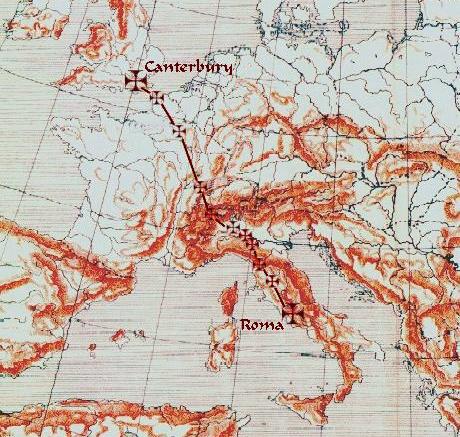The Via Francigena is a historical itinerary leading to Rome from Canterbury, a major route which in the past was used by thousands of pilgrims on their way to Rome.
At the beginning of the 11th century mainly, a multitude of souls "looking for their Lost Heavenly Home" took the habit of travelling across Europe. This route bears witness to the importance of the practice of pilgrimage in medieval times; the pilgrim was to travel mostly on foot (for penitential reasons), covering about 20-25 Km a day,and was driven by a fundamentally devotional reason: the pilgrimage to the Holy Sites of Christianity.There were at the time three main centers of attraction for that journeying humanity:Rome, first of all, the site of the martyrdom of Saint Peter and Saint Paul; Santiago de Compostela, the place chosen by the apostle Saint James to rest in peace and obviously Jerusalem in the Holy Land. The pilgrim did not travel alone but in a group and he used to carry the pilgrimage emblems (the shell for Santiago de Compostela, the cross for Jerusalem and the key for Saint Peter in Rome). Along these very same pilgrim routes, an intense trading activity was carried out and armies followed the same itineraries in the course of their movements.
Thanks to the work of the International Scientific Committee, we are today in a position to retrace this route on the basis of a document left to us by Sigeric, Archibishop of Canterbury. In 994, on his way back to Canterbury from Rome, he described the itinerary and the main stopping places along the way in his memories. Moreover, by agreeing to the requests of the local authorities involved,the Council of Europe has declared the Via Francigena a "European Cultural Itinerary", like the route to Santiago de Compostela in Spain. This recognition testifies to Europe's cultural identity in the broadest sense of the word, by appreciating both its peculiarities and its unity and by laying special emphasis on its artistic patrimony. The Via Francigena represented in fact the union and communication of cultures and ideas belonging to a wide European community expressing then the wish and need for unity which has eventually led today to the breaking-down of national barriers.
La Via Francigena che da Canterbury portava a Roma è un itinerario della storia, una via maestra percorsa in passato da migliaia di pellegrini in viaggio per Roma. Fu soprattutto all'inizio del secondo millenio che l'Europa fu percorsa da una moltitudine di anime "alla ricerca della Perduta Patria Celeste". Questa via attesta infatti l'importanza del pellegrinaggio in epoca medioevale: esso doveva compiersi prevalentemente a piedi (per ragioni penitenziali) con un percorso di 20-25 kilometri al giorno e portava in sé un fondamentale aspetto devozionale: il pellegrinaggio ai Luoghi Santi della religione cristiana. È noto come tre fossero i poli di attrazione per questa umanità in cammino: innanzitutto Roma, luogo del martirio dei Santi Pietro e Paolo; Santiago de Compostela, dove l'apostolo San Giacomo aveva scelto di riposare in pace e naturalmente Gerusalemme in Terra Santa. Il pellegrino inoltre non viaggiava isolato ma in gruppo e portava le insegne del pellegrinaggio (la conchiglia per Santiago de Compostela, la croce per Gerusalemme, la chiave per San Pietro a Roma). Va detto che queste vie di pellegrinaggio erano allo stesso tempo vie di intensi scambi e commerci e che le stesse venivano percorse dagli eserciti nei loro spostamenti.
Grazie al lavoro del Comitato Scientifico Internazionale, oggi siamo in grado di ricostruire questo itinerario sulla base di un documento lasciatoci da Sigerico, Arcivescovo di Canterbury, che nel 994 scrisse, tornando da Roma alla sua diocesi, il diario delle varie tappe toccate durante il viaggio. Inoltre il Consiglio d'Europa, accogliendo le richieste delle reltà locali interessate, ha dichiarato la Via Francigena "Itinerario Culturale Europeo", come il cammino di Santiago de Compostela in Spagna. Si vuole così affermare, nel senso più ampio, l'identità culturale europea nelle sue diversità e nella sua unitarietà, in particolare attraverso la valorizzazione del suo patrimonio monumentale ed artistico. La Via Francigena rappresentò l'unione e la comunicazione tra le varie culture e le idee dei diversi paesi d'Europa, una Europa che oggi vede cadere le barriere ma che già da allora esprimeva il desiderio e la necessità di essere unita.




Commenti
Posta un commento